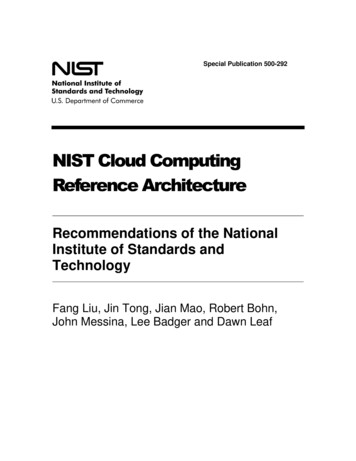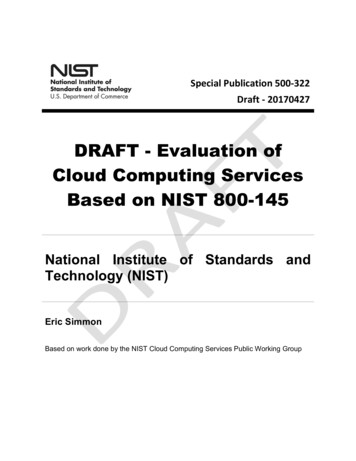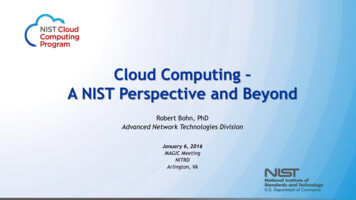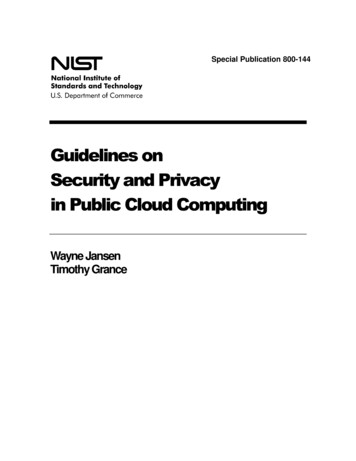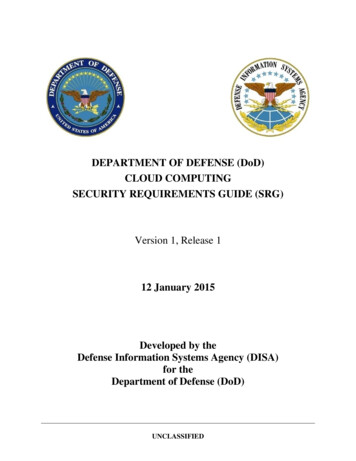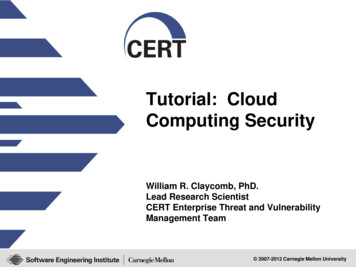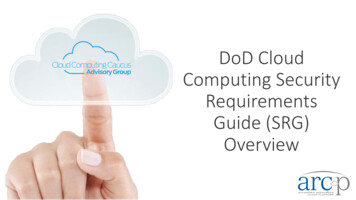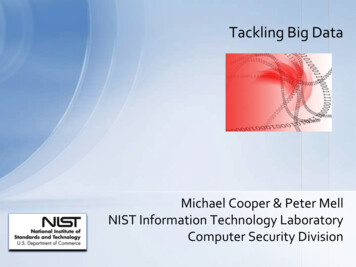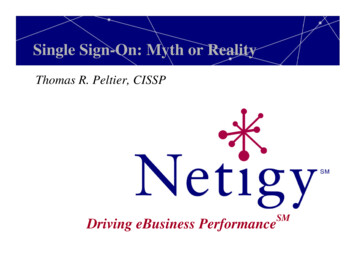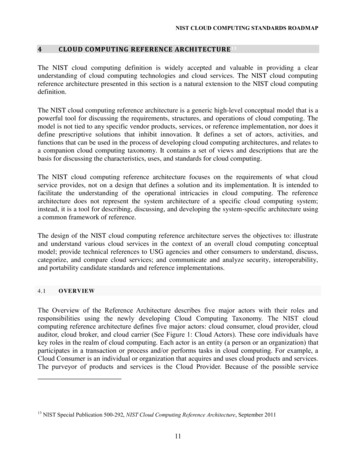
Transcription
NIST CLOUD COMPUTING STANDARDS ROADMAP4CLOUD COMPUTING REFERENCE ARCHITECTURE 13The NIST cloud computing definition is widely accepted and valuable in providing a clearunderstanding of cloud computing technologies and cloud services. The NIST cloud computingreference architecture presented in this section is a natural extension to the NIST cloud computingdefinition.The NIST cloud computing reference architecture is a generic high-level conceptual model that is apowerful tool for discussing the requirements, structures, and operations of cloud computing. Themodel is not tied to any specific vendor products, services, or reference implementation, nor does itdefine prescriptive solutions that inhibit innovation. It defines a set of actors, activities, andfunctions that can be used in the process of developing cloud computing architectures, and relates toa companion cloud computing taxonomy. It contains a set of views and descriptions that are thebasis for discussing the characteristics, uses, and standards for cloud computing.The NIST cloud computing reference architecture focuses on the requirements of what cloudservice provides, not on a design that defines a solution and its implementation. It is intended tofacilitate the understanding of the operational intricacies in cloud computing. The referencearchitecture does not represent the system architecture of a specific cloud computing system;instead, it is a tool for describing, discussing, and developing the system-specific architecture usinga common framework of reference.The design of the NIST cloud computing reference architecture serves the objectives to: illustrateand understand various cloud services in the context of an overall cloud computing conceptualmodel; provide technical references to USG agencies and other consumers to understand, discuss,categorize, and compare cloud services; and communicate and analyze security, interoperability,and portability candidate standards and reference implementations.4.1OVERVIEWThe Overview of the Reference Architecture describes five major actors with their roles andresponsibilities using the newly developing Cloud Computing Taxonomy. The NIST cloudcomputing reference architecture defines five major actors: cloud consumer, cloud provider, cloudauditor, cloud broker, and cloud carrier (See Figure 1: Cloud Actors). These core individuals havekey roles in the realm of cloud computing. Each actor is an entity (a person or an organization) thatparticipates in a transaction or process and/or performs tasks in cloud computing. For example, aCloud Consumer is an individual or organization that acquires and uses cloud products and services.The purveyor of products and services is the Cloud Provider. Because of the possible service13NIST Special Publication 500-292, NIST Cloud Computing Reference Architecture, September 201111
NIST CLOUD COMPUTING STANDARDS ROADMAPofferings (Software, Platform or Infrastructure) allowed for by the cloud provider, there will be ashift in the level of responsibilities for some aspects of the scope of control, security andconfiguration. The Cloud Broker acts as the intermediary between consumer and provider and willhelp consumers through the complexity of cloud service offerings and may also create value-addedcloud services. The Cloud Auditor provides a valuable inherent function for the government byconducting the independent performance and security monitoring of cloud services. The CloudCarrier is the organization which has the responsibility of transferring the data, somewhat akin tothe power distributor for the electric grid.Figure 1 – Cloud Actors briefly lists the five major actors defined in the NIST cloud computingreference architecture.Figure 1 – Cloud Actors12
NIST CLOUD COMPUTING STANDARDS ROADMAPFigure 2 – Interactions between the Actors in Cloud Computing shows the interactions among theactors in the NIST cloud computing reference architecture. A cloud consumer may request cloudservices from a cloud provider directly or via a cloud broker. A cloud auditor conducts independentaudits and may contact the others to collect necessary information. The details will be discussed inthe following sections and be presented as successive diagrams in increasing levels of detail.Figure 2 – Interactions between the Actors in Cloud Computing13
NIST CLOUD COMPUTING STANDARDS ROADMAP4.2CLOUD CONSUMERThe cloud consumer is the ultimate stakeholder that the cloud computing service is created tosupport. A cloud consumer represents a person or organization that maintains a businessrelationship with, and uses the service from, a cloud provider. A cloud consumer browses theservice catalog from a cloud provider, requests the appropriate service, sets up service contractswith the cloud provider, and uses the service. The cloud consumer may be billed for the serviceprovisioned, and needs to arrange payments accordingly. Depending on the services requested, theactivities and usage scenarios can be different among cloud consumers, as shown in Table 1. Someexample usage scenarios are listed in Figure 3.ServiceModelsConsumer ActivitiesProvider ActivitiesSaaSUses application/service forbusiness process operations.Installs, manages, maintains, and supportsthe software application on a cloudinfrastructure.PaaSDevelops, tests, deploys, andmanages applications hosted in acloud system.Provisions and manages cloudinfrastructure and middleware for theplatform consumers; providesdevelopment, deployment, andadministration tools to platform consumers.IaaSCreates/installs, manages, andmonitors services for ITinfrastructure operations.Provisions and manages the physicalprocessing, storage, networking, and thehosting environment and cloudinfrastructure for IaaS consumers.Table 1 – Cloud Consumer and Cloud Provider14
NIST CLOUD COMPUTING STANDARDS ROADMAPFigure 3 – Example of Services Available to a Cloud ConsumerSaaS applications are usually deployed as hosted services and are accessed via a networkconnecting SaaS consumers and providers. The SaaS consumers can be organizations that providetheir members with access to software applications, end users who directly use softwareapplications, or software application administrators who configure applications for end users. SaaSconsumers access and use applications on demand, and can be billed on the number of consumers orthe amount of consumed services. The latter can be measured in terms of the time in use, thenetwork bandwidth consumed, or the amount/duration of data stored.15
NIST CLOUD COMPUTING STANDARDS ROADMAPFor PaaS, cloud consumers employ the tools and execution resources provided by cloud providersfor the purpose of developing, testing, deploying, and managing applications hosted in a cloudsystem. PaaS consumers can be application developers who design and implement applicationsoftware, application testers who run and test applications in various cloud systems, applicationdeployers who publish applications into a cloud system, and application administrators whoconfigure and monitor application performance on a platform. PaaS consumers can be billed by thenumber of consumers, the type of resources consumed by the platform, or the duration of platformusage.For IaaS, consumers are provisioned with the capabilities to access virtual computers, networkaccessible storage, network infrastructure components, and other fundamental computing resources,on which consumers can deploy and run arbitrary software. IaaS consumers can be systemdevelopers, system administrators, and information technology (IT) managers who are interested increating, installing, managing and monitoring services for IT infrastructure operations. IaaSconsumers are provisioned with the capabilities to access these computing resources, and are billedfor the amount of resources consumed.4.3CLOUD PROVIDERFigure 4 – Cloud Provider: Major Activities16
NIST CLOUD COMPUTING STANDARDS ROADMAPA cloud provider can be a person, an organization, or an entity responsible for making a serviceavailable to cloud consumers. A cloud provider builds the requested software/platform/infrastructure services, manages the technical infrastructure required for providing the services,provisions the services at agreed-upon service levels, and protects the security and privacy of theservices. As illustrated in Figure 4 – Cloud Provider: Major Activities, cloud providers undertakedifferent tasks for the provisioning of the various service models.For SaaS, the cloud provider deploys, configures, maintains, and updates the operation of thesoftware applications on a cloud infrastructure so that the services are provisioned at the expectedservice levels to cloud consumers. The provider of SaaS assumes most of the responsibilities inmanaging and controlling the applications and the infrastructure, while the cloud consumers havelimited administrative control of the applications.For PaaS, the cloud provider manages the cloud infrastructure for the platform, and provisions toolsand execution resources for the platform consumers to develop, test, deploy, and administerapplications. Consumers have control over the applications and possibly the hosting environmentsettings, but cannot access the infrastructure underlying the platform including network, servers,operating systems, or storage.For IaaS, the cloud provider provisions the physical processing, storage, networking, and otherfundamental computing resources, as well as manages the hosting environment and cloudinfrastructure for IaaS consumers. Cloud consumers deploy and run applications, have more controlover the hosting environment and operating systems, but do not manage or control the underlyingcloud infrastructure (e.g., the physical servers, network, storage, hypervisors, etc.).The activities of cloud providers can be discussed in greater detail from the perspectives of ServiceDeployment, Service Orchestration, Cloud Service Management, Security and Privacy.4.3.1SERVICE DEPLOYMENTAs identified in the NIST cloud computing definition, a cloud infrastructure may be operated in oneof the following deployment models: public cloud, private cloud, community cloud, or hybrid cloud.For the details related to the controls and management in the cloud, we refer readers to the NISTSpecial Publication 800-146, NIST Cloud Computing Synopsis and Recommendations.A public cloud is one in which the cloud infrastructure and computing resources are made availableto the general public over a public network. A public cloud is owned by an organization sellingcloud services and serves a diverse pool of clients.For private clouds, the cloud infrastructure is operated exclusively for a single organization. Aprivate cloud gives the organization exclusive access to and usage of the infrastructure andcomputational resources. It may be managed either by the organization or by a third party, and may17
NIST CLOUD COMPUTING STANDARDS ROADMAPbe implemented at the organization’s premise (i.e., on-site private clouds) or outsourced to a hostingcompany (i.e., outsourced private clouds).Similar to private clouds, a community cloud may be managed by the organizations or by a thirdparty, and may be implemented at the customer’s location (i.e., on-site community cloud) oroutsourced to a hosting company (i.e., outsourced community cloud). However, a community cloudserves a set of organizations that have common security, privacy, and compliance considerations,rather than serving a single organization as does a private cloud.A hybrid cloud is a composition of two or more cloud deployment models (private, community, orpublic) that remain unique entities but are bound together by standardized or proprietary technologythat enables data and application portability. As discussed in this section, both private clouds andcommunity clouds can be either implemented on-site or outsourced to a third party. Therefore, eachconstituent cloud of a hybrid cloud can be one of the five variants.4.3.2SERVICE ORCHESTRATIONService orchestration refers to the arrangement, coordination, and management of cloudinfrastructure to provide the optimizing capabilities of cloud services, as a cost-effective way ofmanaging IT resources, as dictated by strategic business requirements. Figure 5 shows the generalrequirements and processes for cloud providers to build each of the three service models.Figure 5 – Cloud Provider: Service Orchestration18
NIST CLOUD COMPUTING STANDARDS ROADMAPA three-layered framework is identified for a generalized cloud system in Figure 5. The top layer isthe service layer, where a cloud provider defines and provisions each of the three service models.This is where cloud consumers consume cloud services through the respective cloud interfaces.The middle layer is the resource abstraction and control layer. This layer contains the systemcomponents that a cloud provider uses to provide and manage access to the physical computingresources through software abstraction. The layer typically includes software elements such ashypervisors, virtual machines, virtual data storage, and other resource abstraction and managementcomponents needed to ensure efficient, secure, and reliable usage. While virtual machinetechnology is commonly used at this layer, other means of providing the necessary softwareabstractions are not precluded. This layer provides “cloud readiness” with the five characteristicsdefined in the NIST definition of cloud computing.The lowest layer in the framework is the physical resource layer, which includes all the physicalcomputing resources. This layer includes hardware resources, such as computers (CPU andmemory), networks (routers, firewalls, switches, network links, and interfaces), storage components(hard disks), and other physical computing infrastructure elements. It also includes facilitiesresources, such as heating, ventilation, and air conditioning (HVAC), power, communications, andother aspects of the physical plant.Note that in this framework, the horizontal positioning of layers implies a stack in which the upperlayer has a dependency on the lower layer. The resource abstraction and control layer build virtualcloud resources on top of the underlying physical resource layer and support the service layer wherecloud services interfaces are exposed. The three service models can be built either on top of oneanother (i.e., SaaS built upon PaaS and PaaS built upon IaaS) or directly upon the underlying cloudinfrastructure. For example, a SaaS application can be implemented and hosted on virtual machinesfrom IaaS or directly on top of cloud resources without using IaaS.4.3.3CLOUD SERVICE MANAGEMENTCloud Service Management includes all of the service-related functions that are necessary for themanagement and operation of those services required by or proposed to cloud consumers. Asillustrated in Figure 6, cloud service management can be described from the perspective of businesssupport, provisioning and configuration, and from the perspective of portability andinteroperability requirements.19
NIST CLOUD COMPUTING STANDARDS ROADMAPPortability /Cloud ServiceManagementBusinessProvisioning /SupportConfigurationCustomer MgmtContract MgmtInventory MgmtCloudConsumersInteroperabilityAccounting& BillingReporting &AuditingData PortabilityCopy Date To-FromRapid ProvisioningBulk DataTransferResource ChangeMonitoring &ReportingMeteringServiceInteroperabilityUnified A ManagementVM ImagesMigrationPricing &RatingApplication /SVC MigrationFigure 6 – Cloud Provider: Cloud Service Management4.3.4SECURITY“As the Federal Government moves to the cloud, it must be vigilant to ensure the security andproper management of government information to protect the privacy of citizens and nationalsecurity” (by Vivek Kundra, Federal Cloud Computing Strategy, February 2011.) In July 2012, theU.S. Department of Defense released a Cloud Computing Strategy, which stated “the Departmenthas specific cloud computing challenges that require careful adoption considerations, especially inareas of cybersecurity, continuity of operations, information assurance (IA), and resilience.” Also,in November 2012, NIST published a White Paper – Challenging Security Requirements for U.S.Government Cloud Computing Adoption. This document provides an overview of the high-prioritysecurity challenges perceived by federal agencies as impediments to the adoption of cloudcomputing.20
NIST CLOUD COMPUTING STANDARDS ROADMAPSecurity is a cross-cutting function that spans all layers of the reference architecture (see Figure 12– The Combined Conceptual Reference Diagram), involving end-to-end security that ranges fromphysical security to application security, and in general, the responsibility is shared between cloudprovider and federal cloud consumer. For example, the protection of the physical resource layer (seeFigure 5 – Cloud Provider: Service Orchestration) requires physical security that deniesunauthorized access to the building, facility, resource, or stored information. Cloud Providersshould ensure that the facility hosting cloud services is secure and that the staff has properbackground checks. When data or applications are moved to a cloud, Cloud Consumers ensure thatthe cloud offering satisfies the security requirements and enforces the compliance rules. SeveralU.S. government agencies provide computer security guidance, and that the cloud system shouldsupport the most up-to-date guidance. It is also important to note that security, compliance, andpolicy requirements are a function of the legal jurisdiction of the country in which the cloudservices are provided and can vary from country to country. An independent audit (see Section 3.4)should be conducted to verify the compliance with regulations or security policies.4.3.5PRIVACYCloud providers should protect the assured, proper, and consistent collection, processing,communication, use, and disposition of personal information (PI) and personally identifiableinformation (PII) in the cloud system. PII is the information that can be used to distinguish or tracean individual’s identity, such as name, social security number, biometric records, etc., alone, orwhen combined with other personal or identifying information that is linked or linkable to a specificindividual, such as date and place of birth, mother’s maiden name, etc. The CIO Council – PrivacyCommittee14 has identified privacy and protection of collected PII as one of the federal governmentkey business imperatives. Though cloud computing provides a flexible solution for sharedresources, software, and information, it also poses additional privacy challenges to consumers usingthe clouds.The Digital Government Strategy15 issued by the Federal Chief Information Officer (CIO) on May23, 2012 sets forth a new vision of how government is to connect with and provide services to theAmerican people, harnessing the power of digital technology and enabling citizens and the federalworkforce to securely access government digital information, data, and services anywhere, ittee/15Digital Government: Building a 21st Century Platform to Better Serve the American People (May 23, 2012),(Strategy) egov/digital-government/digital-government.html21
NIST CLOUD COMPUTING STANDARDS ROADMAPanytime (Recommendations).16 The Federal CIO Council released Recommendations forStandardized Implementation of Digital Privacy Controls (Recommendations), which discussesthree fundamental privacy controls: PII Inventory, Privacy Impact Assessment (PIA), and PrivacyNotice. The Recommendations are that agencies identify and consider all PII that may be collectedor otherwise exposed through a particular digital technology, analyze the privacy risks through thedata life cycle by conducting and updating a PIA (as needed), an
definition. The NIST cloud computing reference architecture is a generic high-level conceptual model that is a powerful tool for discussing the requirements, structures, and operations of cloud computing. The model is not tied to any specific vendor pro

